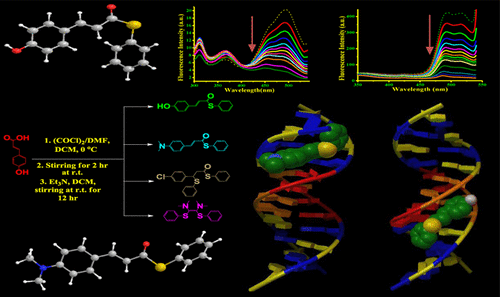Our official English website, www.x-mol.net, welcomes your
feedback! (Note: you will need to create a separate account there.)
Fluorescent Small Molecules Are BIG Enough To Sense Biomacromolecule: Synthesis of Aromatic Thioesters and Understanding Their Interactions with ctDNA
ACS Omega ( IF 3.7 ) Pub Date : 2018-01-11 00:00:00 , DOI: 10.1021/acsomega.7b01933 Tamanna Mallick , Abhijit Karmakar , Shaikh Batuta , Giasuddin Ahamed 1 , Sreeparna Das , Md. Niharul Alam , Madhumathan Mukherjee , Nilanjana Das , Debabrata Mandal 1 , Naznin Ara Begum
ACS Omega ( IF 3.7 ) Pub Date : 2018-01-11 00:00:00 , DOI: 10.1021/acsomega.7b01933 Tamanna Mallick , Abhijit Karmakar , Shaikh Batuta , Giasuddin Ahamed 1 , Sreeparna Das , Md. Niharul Alam , Madhumathan Mukherjee , Nilanjana Das , Debabrata Mandal 1 , Naznin Ara Begum
Affiliation

|
The visible fluorescent chromophoric moiety present in the water-soluble photoactive yellow protein (PYP) of Ectothiorhodospira halophila is p-hydroxycinnamic acid linked to the cysteine residue (Cys-69) by a thioester bond and it controls the key photoinduced biological processes of the host organism. In the present work, we have synthesized and characterized three structurally different thiophenyl esters [viz., p-hydroxycinnamic-thiophenyl ester (1), p-N,N-dimethylaminocinnamic-thiophenyl ester (2), and S-phenyl-3-(4-chlorophenyl)-3-(phenylthio)propanethioate (3)] in addition to a novel (to the best of our knowledge) stilbene-type olefinic compound, N1,N1,N2,N2-tetramethyl-1,2-bis(phenylthio)ethene-1,2-diamine (4), under the same reaction condition. All of these four compounds showed characteristic and distinguishable chromophoric/fluorophoric behavior in ethanol and also at pH 7.4. However, we have observed that the intrinsic chromophoric/fluorophoric activities of (1) and (2) were greatly influenced during their interactions with calf-thymus DNA, studied by a range of spectroscopic and physicochemical measurements. We have also applied density functional theory [B3LYP, 6-311G+(d,p)]-based method to get optimized structures of (1) and (2), which were explored further for molecular docking studies to understand their mode of interaction with DNA. The present study opens up their possible applications as fluorescence probes for biomacromolecules like DNA in future.
中文翻译:

荧光小分子足以感知生物大分子:芳族硫代酯的合成及其与ctDNA的相互作用
存在于嗜盐嗜盐单胞菌嗜盐菌的水溶性光敏黄色蛋白(PYP)中的可见荧光发色部分是通过硫酯键与半胱氨酸残基(Cys-69)连接的对羟基肉桂酸,它控制着宿主的主要光诱导生物过程生物。在目前的工作中,我们已经合成并表征三种结构不同噻吩基酯[即,。对-羟基苯硫基酯(1),p - Ñ,Ñ -dimethylaminocinnamic噻吩基酯(2),和小号-苯基-3- (4-氯苯基)-3-(苯硫基)丙硫醇酸酯(3)](根据我们所知)除了一种新型的苯乙烯型烯烃化合物,N 1,N 1,N 2,N 2-四甲基-1,2-双(苯硫基)乙烯-1,2-二胺(4),在相同反应条件下。所有这四种化合物在乙醇中以及在pH 7.4下均表现出特征性和可区分的发色/荧光团行为。但是,我们已经观察到(1)和(2)在与小牛胸腺DNA相互作用的过程中受到了极大的影响,并通过一系列光谱学和理化测量方法进行了研究。我们还应用了基于密度泛函理论[B3LYP,6-311G +(d,p)]的方法来获得(1)和(2)的优化结构,并对其进行了进一步的研究以用于分子对接研究以了解它们的相互作用方式与DNA。本研究开辟了它们将来可能作为诸如DNA之类的生物大分子的荧光探针的应用。
更新日期:2018-01-11
中文翻译:

荧光小分子足以感知生物大分子:芳族硫代酯的合成及其与ctDNA的相互作用
存在于嗜盐嗜盐单胞菌嗜盐菌的水溶性光敏黄色蛋白(PYP)中的可见荧光发色部分是通过硫酯键与半胱氨酸残基(Cys-69)连接的对羟基肉桂酸,它控制着宿主的主要光诱导生物过程生物。在目前的工作中,我们已经合成并表征三种结构不同噻吩基酯[即,。对-羟基苯硫基酯(1),p - Ñ,Ñ -dimethylaminocinnamic噻吩基酯(2),和小号-苯基-3- (4-氯苯基)-3-(苯硫基)丙硫醇酸酯(3)](根据我们所知)除了一种新型的苯乙烯型烯烃化合物,N 1,N 1,N 2,N 2-四甲基-1,2-双(苯硫基)乙烯-1,2-二胺(4),在相同反应条件下。所有这四种化合物在乙醇中以及在pH 7.4下均表现出特征性和可区分的发色/荧光团行为。但是,我们已经观察到(1)和(2)在与小牛胸腺DNA相互作用的过程中受到了极大的影响,并通过一系列光谱学和理化测量方法进行了研究。我们还应用了基于密度泛函理论[B3LYP,6-311G +(d,p)]的方法来获得(1)和(2)的优化结构,并对其进行了进一步的研究以用于分子对接研究以了解它们的相互作用方式与DNA。本研究开辟了它们将来可能作为诸如DNA之类的生物大分子的荧光探针的应用。











































 京公网安备 11010802027423号
京公网安备 11010802027423号